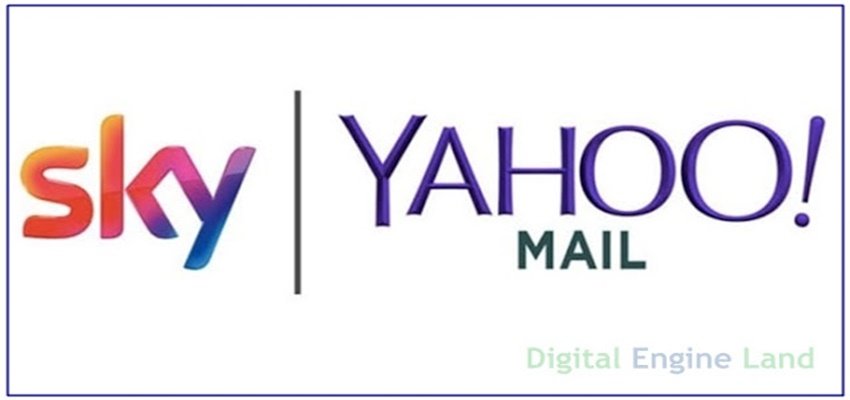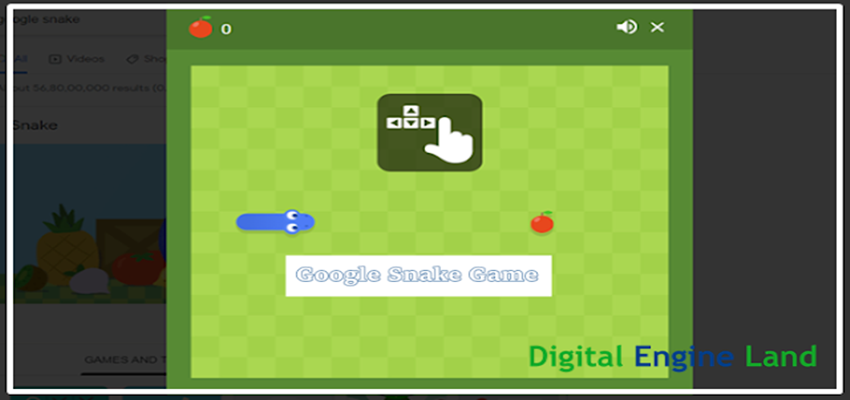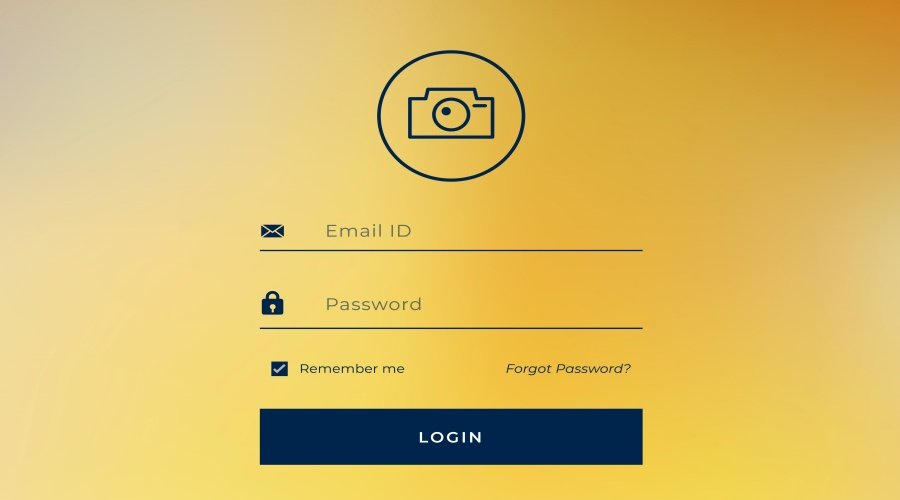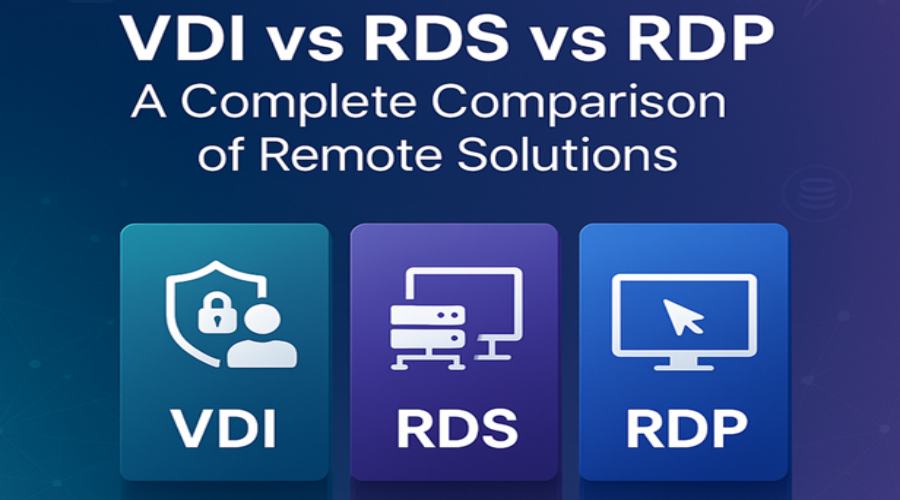
When teams need remote access, the real challenge isn’t choosing a tool; it’s selecting the right remote desktop solution that suits their workflow, security needs, and budget.
That’s where VDI, RDS, and RDP come in, each with a very different purpose.
Use VDI when you need full desktop isolation, such as for developers or compliance-intensive industries.
RDS works best for shared-access environments, like call centers or office staff. And RDP is the go-to for one-on-one access, ideal for remote administration or simple desktop use.
Whether you are comparing cost, performance, deployment, or security, understanding the architectural and operational trade-offs, especially the differences between RDS and RDP, is key to making the right decision.
In this article, we break down VDI vs RDS vs RDP to help IT leaders, sysadmins, and decision-makers confidently match the right solution to their infrastructure needs.
Understanding VDI
VDI (Virtual Desktop Infrastructure) delivers fully isolated virtual desktops from a central server, allowing users secure, customized environments.
It’s a scalable remote desktop solution ideal for developers or industries with strict compliance needs.
How VDI improves data security in remote work lies in centralizing data, not exposing endpoints.
Compared to VDI vs RDS or VDI vs RDP, VDI offers stronger isolation but requires higher infrastructure, licensing, and deployment complexity.
Understanding RDS
Remote Desktop Services (RDS) is a remote access technology that allows multiple users to share sessions on a centralized Windows Server. It’s efficient for running standardized apps with low resource usage.
As part of centralized desktop management, RDS is cost-effective but offers limited user isolation. In RDS vs RDP, RDS supports multi-user access; compared to RDS vs VDI, it lacks full desktop personalization.
Best for call centers, back offices, and task-based roles needing a simple virtual desktop infrastructure.
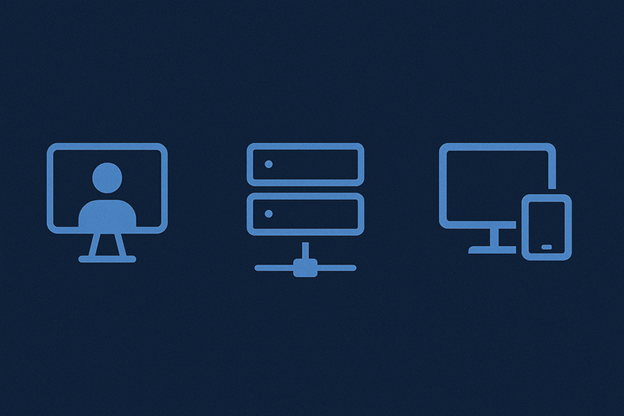
Understanding RDP
Remote Desktop Protocol (RDP) is Microsoft’s native remote desktop protocol, enabling users to connect to a remote Windows machine in a one-to-one session.
It’s ideal for IT-managed remote desktops, remote support, or accessing a hosted desktop environment.
Compared to RDP vs RDS, it lacks multi-user remote desktop support. In RDP vs VDI desktop, RDP is simpler but less secure and customizable.
Best for SMBs, admins, and lightweight remote tasks.
RDP vs VDI vs RDS: Key Decision Factors
Let’s break down the key differences to help you decide how to choose between VDI, RDS, and RDP in real-world use.
Architecture
VDI delivers a full virtual machine desktop per user, RDS uses session-based virtualization on Windows Server remote desktop, and RDP connects directly to a single system.
Understanding the difference between VDI and RDP helps clarify these models for enterprise remote access solutions.
Performance
RDP performs well over LAN with minimal resources. RDS optimizes multi-user loads on shared servers.
VDI provides strong performance when resources are dedicated or scaled in desktop provisioning in cloud environments.
OS Compatibility
VDI supports multiple desktop OS environments, including Linux and Windows.
RDS and RDP are primarily tied to Windows Server remote desktop, limiting flexibility in diverse environments, but are stable for Windows-based infrastructures.
Security & Isolation
VDI offers the strongest secure remote desktop infrastructure with full desktop isolation.
RDS shares resources between sessions, while RDP depends heavily on endpoint security, vital in assessing VDI vs RDS vs rdp security trade-offs.
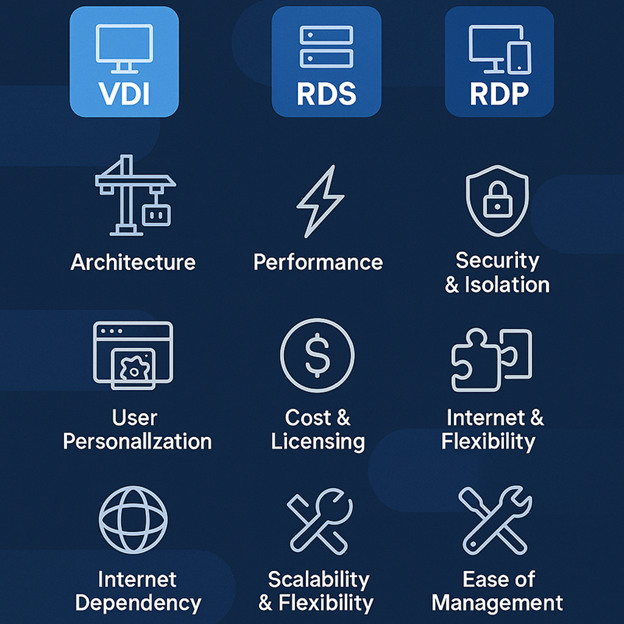
User Personalization
VDI excels in personalization, giving users persistent desktops. RDS limits customization due to shared sessions.
RDP supports personalization only per device, making VDI better for role-specific or power users in the best remote desktop technology for businesses.
Cost & Licensing
RDP has minimal cost (built into Windows). RDS requires Windows Server + CALs.
VDI demands higher investment and complex licensing, but can be optimized through desktop-as-a-service (DaaS) for predictable costs in cloud-first models.
Internet Dependency
RDP and RDS can struggle with latency over public networks. VDI, especially in cloud environments, offers better WAN optimization.
All solutions depend on network quality, but VDI handles remote distribution more efficiently.
Scalability & Flexibility
VDI is highly scalable using desktop provisioning in cloud environments or DaaS platforms.
RDS scales efficiently for task workers. RDP lacks centralized control, making it less suitable for large-scale or dynamic scaling, key in VDI vs RDS vs rdp decisions.
Ease of Management
RDP is simple for small-scale, direct use. RDS offers centralized control with moderate complexity.
VDI requires advanced infrastructure but enables deep automation, critical for enterprise remote access solutions with high IT compliance needs.
Ultimately, understanding the explained factors helps clarify the VDI vs RDS vs RDP landscape, guiding IT teams toward a solution that balances control, scalability, and simplicity.
Comparison of Use Cases: VDI vs RDS vs RDP
Understanding the real-world use cases of each solution is essential when evaluating VDI vs RDS vs RDP for your remote infrastructure.
🔹 When to Use VDI?
Use VDI when your organization requires full desktop isolation, centralized control, and secure endpoint access.
It’s ideal for environments where data security in remote work is critical, like finance, healthcare, or software development.
VDI improves data security in remote work by ensuring sensitive data stays within the data center, not on local devices.
It also supports persistent desktops, deep OS customization, and BYOD strategies.
When you compare RDP, RDS, and VDI for enterprise IT, VDI offers the highest level of user separation and policy enforcement, making it the right choice for teams needing flexibility, compliance, and robust remote desktop experiences at scale.
🔹 When to Use RDS?
Use RDS when you need a cost-effective, centrally managed solution for delivering shared desktops or apps to multiple users.
It’s ideal for standardized workflows like call centers, data entry teams, or internal office tools, making it good for remote work environments that don’t require full OS customization.
In a remote desktop protocols comparison, RDS strikes a balance between performance and resource efficiency using session-based virtualization on a Windows Server remote desktop.
It allows centralized software updates, lower infrastructure cost, and simplified management.
Choose RDS when multi-user access, control, and operational simplicity are more important than full isolation or desktop-level personalization.
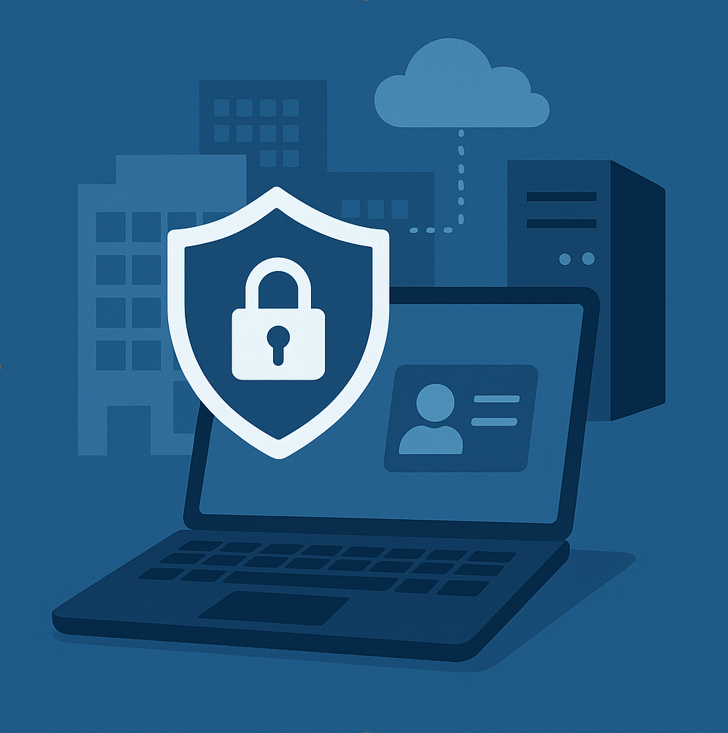
🔹 When to Use RDP?
Use RDP for direct, one-to-one remote access to a Windows desktop, ideal for IT administrators, freelancers, or users needing simple control over a single machine.
It’s lightweight, built into Windows, and perfect for quick support, remote configuration, or accessing office PCs from home.
In the VDI vs RDS vs RDP landscape, RDP is the most straightforward and low-cost solution, but lacks multi-user capabilities and centralized management.
In a desktop virtualization comparison, RDP isn’t true virtualization but a remote desktop protocol.
It’s best suited for SMBs or individual professionals who need reliable remote connectivity without the infrastructure overhead of full virtualization solutions.
Final Comparison Guide: VDI or RDS or RDP
| Criteria | RDP | RDS | VDI |
| Architecture | Direct one-to-one remote desktop protocol | Multi-user session-based virtualization on Windows Server | Full virtual machine desktop per user, isolated environments |
| User Isolation | Minimal, single session | Shared sessions, moderate isolation | Strongest isolation with dedicated OS instances |
| Performance | Lightweight, best on LAN or stable networks | Optimized for multi-user loads, shared resources | High performance with dedicated resources, cloud scalable |
| Scalability | Limited to individual machines | Moderate scalability for many users | Highly scalable via cloud or on-prem desktop provisioning |
| Security | Basic encryption, dependent on endpoint security | Better than RDP, centralized control | Robust, secure remote desktop infrastructure with full data containment |
| User Personalization | Limited to a session, no persistent desktop | Shared environment limits customization | Full personalization, persistent or non-persistent desktops |
| Ease of Management | Simple setup, minimal IT overhead | Centralized management with moderate complexity | Requires advanced management tools and expertise |
| Cost | Low or no extra cost (built-in Windows feature) | Medium, requires Windows Server + CALs | The highest cost is due to infrastructure, licensing, and maintenance |
| Device/OS Flexibility | Windows-focused, limited cross-OS support | Primarily Windows environments | Supports multiple OS types, ideal for heterogeneous devices |
| Best for | SMBs, remote support, and individual users | Office workers, call centers, and standardized apps | Developers, compliance-driven industries, and BYOD environments |
Conclusion
Choosing between VDI vs RDS vs RDP comes down to your organization’s scale, security requirements, and user needs.
For simple, direct access, RDP suits individuals and IT support tasks, making it ideal for small businesses.
RDS balances cost and control for shared environments, perfect for office staff and internal tools. VDI offers the highest isolation, customization, and compliance, ideal for regulated industries or development teams.
To compare RDP, RDS, and VDI for enterprise IT, assess factors like performance, licensing, and device flexibility.
Align your choice with your infrastructure and long-term strategy to ensure efficient, secure, and scalable remote operations.


